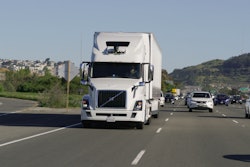 From promising headlines to hangups, Uber’s self-driving truck program is hitting some serious bumps in the road, including accusations that it’s been illegally operating its autonomous truck on California roads.
From promising headlines to hangups, Uber’s self-driving truck program is hitting some serious bumps in the road, including accusations that it’s been illegally operating its autonomous truck on California roads.Editor’s note: The following story refers to Uber’s self-driving car wing as “Otto.” However, the name Otto has since been shuttered, and the self-driving wing of Uber has been brought under its Advanced Technologies Group.
So, how autonomous is Uber’s autonomous truck?
Based on what the State of California has learned so far, the Class 8 semi is not an autonomous vehicle—or at least, according to Uber, it hasn’t been used as such on California’s public roads, which would be a violation of state law.
In an interview with Hard Working Trucks on Tuesday, Jessica Gonzales, assistant deputy director of public affairs with the California Department of Motor Vehicles, explained:
“Representatives from Otto (which was acquired by Uber last year) have told the DMV that the truck technology used in California is the type of advanced driver assistance systems that cannot drive the vehicle without a person in the driver’s seat actively monitoring the vehicle, meaning it wouldn’t be autonomous under California law.”
That’s good news for Uber which has been paired up with some tough headlines lately, including news today that the company fired self-driving engineering whiz Anthony Levandowski for refusing a federal court order to turn over 14,000 documents that he allegedly downloaded from his prior employer, Waymo, one of Uber’s competitors.
Waymo’s lawsuit against Uber alleges that Levandowski stole trade secrets before leaving the company and that those ideas ended up in Uber’s self-driving technology. Uber denies the claim. Levandowski cited the 5th Amendment and refused to turn over any documents over concerns that he would incriminate himself.
Levandowski is credited with starting self-driving truck company Otto, which was acquired by Uber last year and is now facing accusations that it’s been testing its self-driving truck on California highways—a violation of state law which prohibits any vehicle over 10,000 pounds from driving autonomously on public roads.
The accusations and pending inspection from the DMV and CHP follow the publication of an internal Otto document in which the company refers to testing its self-driving truck on a daily basis around San Francisco. This contradicts what Uber told California officials in February, according to Forbes.
Other Otto information made public includes testing procedures on autonomous driving prepared for officials in Colorado. The information varies from what Uber presented to California officials, which has led to state plans for an onsite inspection at Uber’s self-driving truck headquarters in San Francisco.
“The DMV and CHP have planned a site visit in the next several weeks to get a better understanding of the technology that Otto is using in its trucks in California,” Gonzalez said.
In a statement released to Hard Working Trucks on Tuesday, Uber reported that it met with state agencies in February and “any misunderstandings were cleared up.”
The company further stated that it welcomes the visit from the DMV and CHP.
“We have an open invitation to policymakers to visit Uber ATG anytime. We have hosted policymakers from across the country as well as federal lawmakers at our facilities. And we look forward to hosting DMV and CHP when they decide to accept our invitation.”
When asked if the state had any plans to change its law prohibiting large autonomous trucks from operating on state roads, Gonzales said: “The DMV has said that we will work on a separate rulemaking to cover autonomous vehicles over 10,000 pounds after our current driverless testing and deployment regulations are complete.”
In the meantime, if California determines that Uber has been testing its truck in autonomous mode on its public roads, there will be consequences, though when asked Gonzales did not say what those punitive measures might be.
“If someone is found using autonomous technology without a permit, the department would use statutory authority available to take action,” she said.












